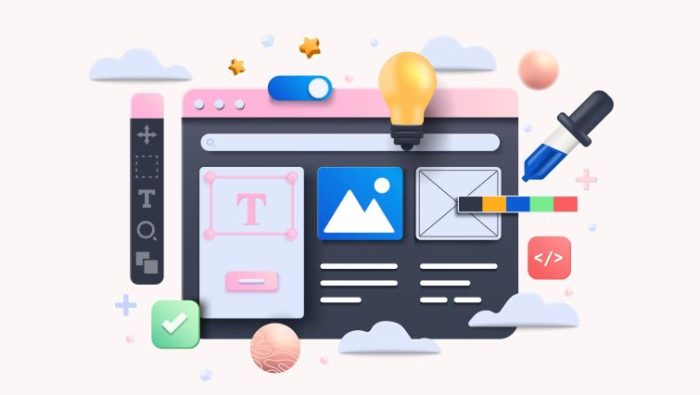6 Web Designer Skills New Graduates Need To Get Hired
 Publié le 9 June 2023
Publié le 9 June 2023
Enter the growing digital job market and find a great career opportunity with 6 web designer skills new graduates need to get hired.
Web design is a highly sought-after career in today’s evolving digital landscape. If you want to get hired as a web designer right after graduation, you’ll need to possess certain skills and understand specific concepts to stand out.
The good news is that you can learn most of these online, not just in a classroom setting. Even if your degree is in a related subject like computer science, graphic design or another field entirely, you don’t really need to be a web design graduate to embark on a lucrative career in the field. Even without extensive experience, you just need a will to keep learning and the determination to be the best among the best. This will help you stand out from other graduates in your field.
That said, here are the 6 web designer skills new graduates need to get hired and get your career off to a strong start.
1. Web Design Principles
To craft a visually appealing and promising website, you don’t just need technical skills. You need to learn basic web design principles as well. These include:
Colour theory: This involves understanding colour psychology and its impact on user perception. An important web designer skill is knowing how to combine primary colors to create new visual elements.
Learn the concept behind contrasting, complementary, and analogous colours and how they work to create a bit of visual dissonance. Why? You could render an unreadable layout if you focus only on bright, conflicting hues.
Use this guide to learn more about colour psychology for design.
Typography: Part of visual design is knowing how to choose appropriate fonts to convey information and enhance readability.
A good web designer knows the difference between type styles and where to use them. For example, Georgia, Verdana, and Roboto fonts are suited to body copy. Meanwhile, decorative typefaces like Serifs are more suitable for ornamentation.

The different font options might make it hard for new web designers to choose. But you can use font combination tools and research various archives for creative ideas about pairings and how these typefaces work in various media.
Composition and Layout: This involves arranging elements on a web page in a visually appealing and functional way.
Observe contrasts, negative space, and proportions in the design to create a well-composed layout. Expand your design knowledge, too. Look at different compositions and know what makes them work. This way, you can replicate them in your own designs.
Visual hierarchy: This determines the order in which elements are presented. You should be able to guide the eye so it sees each design element in the intended order.
A comprehensive understanding of these web designer skills and principles is crucial for creating visually appealing and useful websites, in addition to other forms of online content.
2. HTML and CSS
The 6 web designer skills new graduates need to get hired include a proficiency in HyperText Markup Language (HTML) and Cascading Style Sheets (CSS). These are the building blocks of web design. It’s important to know what they offer and their limitations so you can leverage them when necessary.
HTML helps create a web page’s basic structure and content, making it an essential skill for success in this career path. The HTML code allows you to put headlines, footers, paragraphs and graphics on a website. So, even if you’re building a website with a content management system or no-code editor, HTML knowledge gives you more wiggle room outside these editors to flex your creativity.
The CSS language, on the other hand, handles website layout and design. It tells browsers how to style or format HTML for mobile devices and a wide variety of screen sizes to enhance visual appearance.
Don’t just strive for a solid understanding of CSS and HTML syntax and structure. Know the best practices as well to increase your chances of getting hired as a web designer.
3. JavaScript
A 2020 IT hiring and skills report by Devskiller showed that JavaScript is the most in-demand IT skill based on 40 percent of test invites. The report also showed that 72%of companies running these tests seek JavaScript experts.

All these point to the importance of adding JavaScript to your tech skill set as a recent graduate. This can greatly improve your web design career prospects.
Why is JavaScript important? Well, a website with just HTML and CSS looks good but will not function well without the use of JavaScript. JavaScript is an all-purpose programming language. It powers responsive design features such as drop-down menus, search bars, videos, and buttons to make your site interactive.
Web design aside, learning JavaScript will provide you with transferable key skills as you grow your career. You can get support and amplify your learning by joining JavaScript communities.
4. User Experience Design
UXD (User Experience Design) is the use of navigational elements and intuitive interfaces such as buttons, menus, web pages, and micro-interactions to enhance the user experience.
A good user experience design ensures an uncluttered layout design. To understand UXD and integrate it into a website or digital products, you must be familiar with UX concepts. Here are some of them:
- Information architecture: Knowledge of this can help you declutter the layout and organize website information intuitively and logically for users.
- Usability testing: Knowledge of this can help you assess the usability of a design and evaluate user experience when interacting with a website.
- Accessibility: If you know how to make your site accessible, you can create an equal user experience for people living with disabilities.
But apart from these concepts, you also need to know your audience. It doesn’t matter if you want to design websites for manufacturers or an eCommerce company. User research is crucial in web design, particularly in UXD. If you know how to do this, you can understand user needs and preferences and tailor your web design accordingly.
Along with user research, you’ll need to conduct internal stakeholder interviews to understand industry challenges as well. Then, you have to know how to communicate the appropriate information through impactful design. In this context, there are UX design companies such as Intellectsoft that can play a pivotal role by offering innovative solutions that embody all these essential UXD principles, ensuring that the end product is not only user-friendly but also meets the specific needs of the target audience.
5. CMS and Content Production
Modern websites run on content management systems (CMS) like WordPress, Drupal or Joomla. The most popular ones are a good place to start for beginners. Just focus on one and when you’ve mastered that, you can move on to the next.
Adding CMS management to your list of web designer skills is great. However, it’s also important to have a broader understanding of different types of site content and the ways to create them.
After all, as a web designer, you won’t always create site content for typical retail platforms. You might be required to create content for Software as a Service (SaaS) brands, for example. By expanding your knowledge to include SaaS content production, you’ll be able to create more effective designs for SaaS landing pages, homepages, and others that meet your clients’ needs.
6. Graphic Design
Graphic designers typically work closely with web designers since both jobs require creating visuals. But each position actually entails different things.
Web design focuses on ongoing changes and updates for a project. Graphic design, meanwhile, focuses on long-term visuals. You can also see it this way: a graphic designer generates visuals to communicate the right ideas about digital products or websites. On the other hand, a web designer handles design programming.
The point is, even if they’re different, web design and graphic design are complementary skill sets needed to organize information for effective visual communication.
So, if you want to be hired for on-site or remote work immediately after graduation, it pays to have knowledge of both graphic design and web design. Besides, you can charge more for a web design project. After all, you’ll be doing two design jobs.
Knowing graphic design also entails learning how to use graphic design software. As a beginner, familiarize yourself with Adobe Creative Cloud programs like:
- Adobe Illustrator
- Adobe Photoshop
- Adobe Indesign
- Adobe Lightroom
Also, consider expanding your toolset knowledge by learning Sketch and Figma.
Different design teams or designers may prefer one tool over the other. However, you should consider subscribing to Envato elements for unlimited access to an exhaustive content library of graphic assets and design templates. Why? This will likely save you time and effort on solo web design work or team projects.
Starting Your Career in Web Design
There’s more to the web design process than building basic websites. A design project could have several professionals like copywriters and product designers on the team. If you want to increase your chances of getting hired, you’ll want to learn a little bit of everything to stand out.
You learned the 6 web designer skills new graduates need to get hired. These are:
- Web design principles
- HTML and CSS
- JavaScript
- User experience design
- CMS and content production
- Graphic design
Of course, you also need to be a better team player. Developing soft skills like communication and learning remote collaboration tools will help. You’ll also need time management and project management skills to improve productivity and output. As long as you can include these skills in your graduate resume and write a cover letter that highlights academic achievements, you can make it clear to a hiring manager that you are fully prepared to move from the graduation stage to the workplace.
By focusing on the learning and using the 6 web designer skills new graduates need to get hired, you will set yourself up for success as you go from school into the job market.







